[English] 日本語
 Yorodumi
Yorodumi- PDB-7tlz: SARS-CoV-2 S NTD B.1.1.529 Omicron variant + S309 Local Refinement -
+ Open data
Open data
- Basic information
Basic information
| Entry | Database: PDB / ID: 7tlz | ||||||
|---|---|---|---|---|---|---|---|
| Title | SARS-CoV-2 S NTD B.1.1.529 Omicron variant + S309 Local Refinement | ||||||
 Components Components |
| ||||||
 Keywords Keywords | VIRUS/IMMUNE SYSTEM / omicron / receptor-binding domain / SARS-CoV-2 / covid / B.1.529 / NTD / antibody / Fab / S2L20 / Structural Genomics / Seattle Structural Genomics Center for Infectious Disease / SSGCID / VIRUS-IMMUNE SYSTEM complex | ||||||
| Function / homology |  Function and homology information Function and homology informationMaturation of spike protein / viral translation / Translation of Structural Proteins / Virion Assembly and Release / host cell surface / host extracellular space / suppression by virus of host tetherin activity / Induction of Cell-Cell Fusion / structural constituent of virion / entry receptor-mediated virion attachment to host cell ...Maturation of spike protein / viral translation / Translation of Structural Proteins / Virion Assembly and Release / host cell surface / host extracellular space / suppression by virus of host tetherin activity / Induction of Cell-Cell Fusion / structural constituent of virion / entry receptor-mediated virion attachment to host cell / host cell endoplasmic reticulum-Golgi intermediate compartment membrane / receptor-mediated endocytosis of virus by host cell / membrane fusion / Attachment and Entry / positive regulation of viral entry into host cell / receptor-mediated virion attachment to host cell / receptor ligand activity / host cell surface receptor binding / symbiont-mediated suppression of host innate immune response / fusion of virus membrane with host plasma membrane / fusion of virus membrane with host endosome membrane / viral envelope / virion attachment to host cell / SARS-CoV-2 activates/modulates innate and adaptive immune responses / host cell plasma membrane / virion membrane / identical protein binding / membrane / plasma membrane Similarity search - Function | ||||||
| Biological species |  Homo sapiens (human) Homo sapiens (human) | ||||||
| Method | ELECTRON MICROSCOPY / single particle reconstruction / cryo EM / Resolution: 3.3 Å | ||||||
 Authors Authors | McCallum, M. / Veesler, D. / Seattle Structural Genomics Center for Infectious Disease (SSGCID) | ||||||
| Funding support |  United States, 1items United States, 1items
| ||||||
 Citation Citation |  Journal: Science / Year: 2022 Journal: Science / Year: 2022Title: Structural basis of SARS-CoV-2 Omicron immune evasion and receptor engagement. Authors: Matthew McCallum / Nadine Czudnochowski / Laura E Rosen / Samantha K Zepeda / John E Bowen / Alexandra C Walls / Kevin Hauser / Anshu Joshi / Cameron Stewart / Josh R Dillen / Abigail E ...Authors: Matthew McCallum / Nadine Czudnochowski / Laura E Rosen / Samantha K Zepeda / John E Bowen / Alexandra C Walls / Kevin Hauser / Anshu Joshi / Cameron Stewart / Josh R Dillen / Abigail E Powell / Tristan I Croll / Jay Nix / Herbert W Virgin / Davide Corti / Gyorgy Snell / David Veesler /    Abstract: The severe acute respiratory syndrome coronavirus 2 (SARS-CoV-2) Omicron variant of concern evades antibody-mediated immunity that comes from vaccination or infection with earlier variants due to ...The severe acute respiratory syndrome coronavirus 2 (SARS-CoV-2) Omicron variant of concern evades antibody-mediated immunity that comes from vaccination or infection with earlier variants due to accumulation of numerous spike mutations. To understand the Omicron antigenic shift, we determined cryo-electron microscopy and x-ray crystal structures of the spike protein and the receptor-binding domain bound to the broadly neutralizing sarbecovirus monoclonal antibody (mAb) S309 (the parent mAb of sotrovimab) and to the human ACE2 receptor. We provide a blueprint for understanding the marked reduction of binding of other therapeutic mAbs that leads to dampened neutralizing activity. Remodeling of interactions between the Omicron receptor-binding domain and human ACE2 likely explains the enhanced affinity for the host receptor relative to the ancestral virus. | ||||||
| History |
|
- Structure visualization
Structure visualization
| Movie |
 Movie viewer Movie viewer |
|---|---|
| Structure viewer | Molecule:  Molmil Molmil Jmol/JSmol Jmol/JSmol |
- Downloads & links
Downloads & links
- Download
Download
| PDBx/mmCIF format |  7tlz.cif.gz 7tlz.cif.gz | 128.4 KB | Display |  PDBx/mmCIF format PDBx/mmCIF format |
|---|---|---|---|---|
| PDB format |  pdb7tlz.ent.gz pdb7tlz.ent.gz | 82.9 KB | Display |  PDB format PDB format |
| PDBx/mmJSON format |  7tlz.json.gz 7tlz.json.gz | Tree view |  PDBx/mmJSON format PDBx/mmJSON format | |
| Others |  Other downloads Other downloads |
-Validation report
| Summary document |  7tlz_validation.pdf.gz 7tlz_validation.pdf.gz | 1.4 MB | Display |  wwPDB validaton report wwPDB validaton report |
|---|---|---|---|---|
| Full document |  7tlz_full_validation.pdf.gz 7tlz_full_validation.pdf.gz | 1.4 MB | Display | |
| Data in XML |  7tlz_validation.xml.gz 7tlz_validation.xml.gz | 32.3 KB | Display | |
| Data in CIF |  7tlz_validation.cif.gz 7tlz_validation.cif.gz | 43.5 KB | Display | |
| Arichive directory |  https://data.pdbj.org/pub/pdb/validation_reports/tl/7tlz https://data.pdbj.org/pub/pdb/validation_reports/tl/7tlz ftp://data.pdbj.org/pub/pdb/validation_reports/tl/7tlz ftp://data.pdbj.org/pub/pdb/validation_reports/tl/7tlz | HTTPS FTP |
-Related structure data
| Related structure data |  25991MC  7tlyC  7tm0C 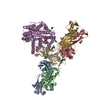 7tn0C C: citing same article ( M: map data used to model this data |
|---|---|
| Similar structure data |
- Links
Links
- Assembly
Assembly
| Deposited unit | 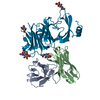
|
|---|---|
| 1 |
|
- Components
Components
| #1: Antibody | Mass: 11829.141 Da / Num. of mol.: 1 Source method: isolated from a genetically manipulated source Source: (gene. exp.)  Homo sapiens (human) / Production host: Homo sapiens (human) / Production host:  Homo sapiens (human) Homo sapiens (human) | ||||||
|---|---|---|---|---|---|---|---|
| #2: Antibody | Mass: 13541.036 Da / Num. of mol.: 1 Source method: isolated from a genetically manipulated source Source: (gene. exp.)  Homo sapiens (human) / Production host: Homo sapiens (human) / Production host:  Homo sapiens (human) Homo sapiens (human) | ||||||
| #3: Protein | Mass: 141600.328 Da / Num. of mol.: 1 Source method: isolated from a genetically manipulated source Source: (gene. exp.)  Homo sapiens (human) / Gene: S, 2 / Production host: Homo sapiens (human) / Gene: S, 2 / Production host:  Homo sapiens (human) / References: UniProt: P0DTC2 Homo sapiens (human) / References: UniProt: P0DTC2 | ||||||
| #4: Sugar | ChemComp-NAG / Has ligand of interest | N | Has protein modification | Y | Sequence details | There is an insertion of three residues EPE between residues R214 and D215 that are numbered E9215, ...There is an insertion of three residues EPE between residues R214 and D215 that are numbered E9215, P9216, E9217. | |
-Experimental details
-Experiment
| Experiment | Method: ELECTRON MICROSCOPY |
|---|---|
| EM experiment | Aggregation state: PARTICLE / 3D reconstruction method: single particle reconstruction |
- Sample preparation
Sample preparation
| Component | Name: SARS-CoV-2 S NTD B.1.1.529 Omicron variant + S2L20 / Type: COMPLEX / Entity ID: #1-#3 / Source: MULTIPLE SOURCES | ||||||||||||
|---|---|---|---|---|---|---|---|---|---|---|---|---|---|
| Molecular weight | Experimental value: NO | ||||||||||||
| Source (natural) |
| ||||||||||||
| Source (recombinant) | Organism:  Homo sapiens (human) Homo sapiens (human) | ||||||||||||
| Buffer solution | pH: 8 | ||||||||||||
| Specimen | Embedding applied: NO / Shadowing applied: NO / Staining applied: NO / Vitrification applied: YES | ||||||||||||
| Vitrification | Cryogen name: ETHANE |
- Electron microscopy imaging
Electron microscopy imaging
| Experimental equipment |  Model: Titan Krios / Image courtesy: FEI Company |
|---|---|
| Microscopy | Model: FEI TITAN KRIOS |
| Electron gun | Electron source:  FIELD EMISSION GUN / Accelerating voltage: 300 kV / Illumination mode: FLOOD BEAM FIELD EMISSION GUN / Accelerating voltage: 300 kV / Illumination mode: FLOOD BEAM |
| Electron lens | Mode: BRIGHT FIELD / Nominal defocus max: 2000 nm / Nominal defocus min: 300 nm |
| Image recording | Electron dose: 63 e/Å2 / Film or detector model: GATAN K3 (6k x 4k) |
- Processing
Processing
| CTF correction | Type: PHASE FLIPPING AND AMPLITUDE CORRECTION |
|---|---|
| 3D reconstruction | Resolution: 3.3 Å / Resolution method: FSC 0.143 CUT-OFF / Num. of particles: 94770 / Symmetry type: POINT |
 Movie
Movie Controller
Controller





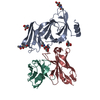
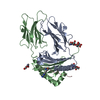
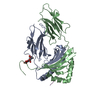
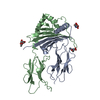
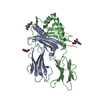
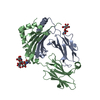
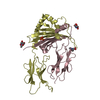
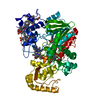
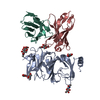

 PDBj
PDBj







